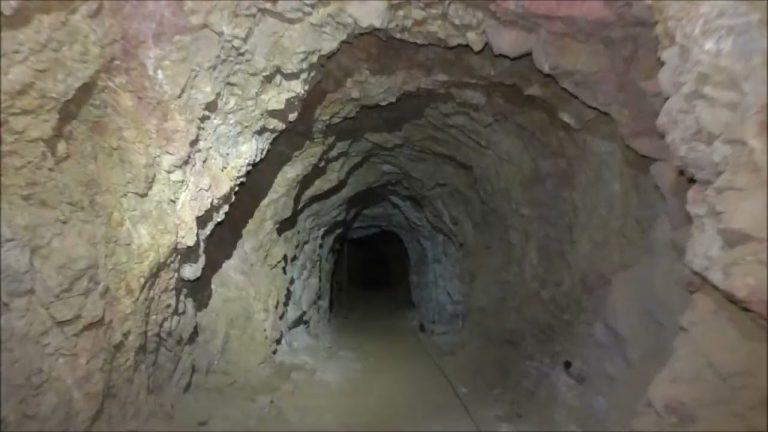Assessing The Risks: Toxic Pollution From Abandoned Gold Mines

Table of Contents
H2: Types of Toxic Pollution from Abandoned Gold Mines
Abandoned gold mines release a cocktail of hazardous substances into the environment. Understanding these pollutants is crucial to addressing the risks effectively.
H3: Heavy Metal Contamination
The leaching of heavy metals is a primary concern. Gold ore often contains significant quantities of arsenic, mercury, lead, and cadmium. These metals, highly toxic even at low concentrations, contaminate soil, water, and air through various processes like weathering and runoff.
- Arsenic: Exposure can lead to skin lesions, cardiovascular disease, and various cancers.
- Mercury: Known for its neurotoxic effects, mercury can cause developmental problems in children and neurological damage in adults.
- Lead: Affects the nervous system, particularly in children, leading to developmental delays and learning disabilities.
- Cadmium: Primarily targets the kidneys, causing kidney damage and potentially contributing to bone disorders.
The abandoned gold mines of California’s Sierra Nevada mountains, for instance, have left a significant legacy of mercury contamination in the surrounding waterways. These heavy metals persist in the environment for decades, if not centuries, posing a continuous threat.
H3: Acid Mine Drainage (AMD)
Acid mine drainage (AMD) is another significant pollution source. It forms when sulfide minerals in exposed mine waste react with air and water, producing sulfuric acid. This acidic water leaches heavy metals from the surrounding rock, further amplifying the pollution problem.
- Chemical Processes: The oxidation of pyrite (iron sulfide) is a key process in AMD formation. This reaction produces sulfuric acid, which lowers the pH of water and increases the solubility of heavy metals.
- Impact on Aquatic Life: AMD severely impacts aquatic ecosystems, causing fish kills and harming other organisms due to low pH and high metal concentrations.
- Remediation Challenges: AMD remediation is costly and complex, often requiring extensive engineering solutions and long-term monitoring.
H3: Cyanide Contamination
Cyanide is frequently used in gold extraction processes. Leaks or spills from abandoned cyanide-processing facilities pose a severe threat.
- Acute Toxicity: Cyanide is a potent poison, causing immediate respiratory failure and death at high doses.
- Chronic Toxicity: Chronic exposure can lead to various health problems, including thyroid issues and neurological disorders.
- Environmental Impacts: Cyanide contamination in water bodies can decimate aquatic life, while soil contamination affects plant growth and overall ecosystem health. Stringent regulations and safety protocols are crucial for handling cyanide, even in abandoned mine settings.
H2: Assessing the Environmental and Health Risks
The consequences of toxic pollution from abandoned gold mines extend far beyond the immediate mine site, impacting water resources, terrestrial ecosystems, and human health.
H3: Impact on Water Resources
Contaminated water from abandoned mines poses a significant risk to human health. Drinking water sources can be easily compromised, leading to various health problems.
- Human Health Consequences: Heavy metal exposure through contaminated drinking water can cause cancer, developmental problems in children, and numerous other health issues.
- Aquatic Ecosystem Impacts: AMD and heavy metal pollution decimate aquatic life, disrupting the delicate balance of aquatic ecosystems and causing biodiversity loss.
- Monitoring Challenges: Monitoring water quality around abandoned mines is challenging due to the vast area and complex hydrogeology.
H3: Impact on Soil and Terrestrial Ecosystems
Heavy metal contamination affects soil fertility, making it difficult for plants to grow and thrive. This impacts the entire food chain.
- Bioaccumulation: Heavy metals accumulate in the tissues of plants and animals, leading to biomagnification—increasing concentrations as you move up the food chain.
- Biodiversity Loss: Soil contamination reduces biodiversity, leading to the loss of important ecosystem services, such as pollination and nutrient cycling.
- Remediation Challenges: Soil remediation is a lengthy and expensive process, often requiring excavation and specialized treatment methods.
H3: Human Health Impacts
Exposure to pollutants from abandoned gold mines poses severe health risks, particularly for communities living near these sites.
- Specific Health Conditions: Heavy metal poisoning leads to neurological disorders, kidney disease, respiratory problems, and various cancers.
- Diagnosis Challenges: Diagnosing heavy metal poisoning can be difficult, requiring specialized testing and expertise.
- Socio-economic Impacts: The health impacts often lead to reduced productivity, increased healthcare costs, and overall decreased quality of life in affected communities.
H2: Remediation and Mitigation Strategies
Addressing the legacy of abandoned gold mine pollution requires a multifaceted approach incorporating both passive and active remediation techniques, as well as strong regulatory frameworks.
H3: Passive Remediation Techniques
Passive techniques utilize natural processes to mitigate pollution.
- Wetland Creation: Constructed wetlands can effectively remove heavy metals and reduce AMD acidity.
- Bioremediation: Using microorganisms to break down pollutants can be a cost-effective method.
- Advantages and Limitations: Passive methods are generally less expensive than active methods but may be slower and less effective in severely contaminated sites.
H3: Active Remediation Techniques
Active remediation involves more direct intervention to remove or neutralize pollutants.
- Excavation: Removing contaminated soil and waste is often necessary for severely impacted areas.
- Chemical Treatment: Neutralizing AMD or precipitating heavy metals can reduce their mobility and toxicity.
- Costs and Challenges: Active remediation is significantly more expensive than passive techniques and requires specialized expertise.
H3: Regulatory and Policy Frameworks
Strong regulations and international cooperation are crucial for preventing future pollution and addressing existing contamination.
- Environmental Regulations: National and international regulations are essential to setting standards for mine closure and remediation.
- Enforcement and Monitoring: Effective enforcement and ongoing monitoring are vital to ensuring compliance and protecting public health and the environment.
3. Conclusion
The risks associated with toxic pollution from abandoned gold mines are substantial, encompassing widespread environmental damage and severe public health consequences. The long-term persistence of these pollutants highlights the urgent need for comprehensive remediation strategies and preventative measures. We must proactively address abandoned gold mine pollution through responsible mining practices, effective remediation programs, and robust regulatory frameworks. Learn more about the impact of toxic waste from abandoned mines and support organizations working to remediate these sites. Advocate for stronger regulations and improved mining practices to prevent the creation of future abandoned gold mine pollution sites. Let's work together to clean up the legacy of the past and protect our environment for future generations.

Featured Posts
-
 White Lotus Patrik Svarceneger I Teret Poznatog Prezimena
May 06, 2025
White Lotus Patrik Svarceneger I Teret Poznatog Prezimena
May 06, 2025 -
 Trotyl Z Polski Dla Amerykanskiej Armii Szczegoly Kontraktu
May 06, 2025
Trotyl Z Polski Dla Amerykanskiej Armii Szczegoly Kontraktu
May 06, 2025 -
 Following In Giant Footsteps Evaluating The Sequel Website
May 06, 2025
Following In Giant Footsteps Evaluating The Sequel Website
May 06, 2025 -
 Eksport Trotylu Z Polski Analiza Duzego Zamowienia
May 06, 2025
Eksport Trotylu Z Polski Analiza Duzego Zamowienia
May 06, 2025 -
 Priyanka Chopra And Nick Jonas A Closer Look At Their Holi Festivities
May 06, 2025
Priyanka Chopra And Nick Jonas A Closer Look At Their Holi Festivities
May 06, 2025
Latest Posts
-
 2000
May 06, 2025
2000
May 06, 2025 -
 How Priyanka Chopra And Nick Jonas Celebrated Holi
May 06, 2025
How Priyanka Chopra And Nick Jonas Celebrated Holi
May 06, 2025 -
 Priyanka And Nicks Holi A Look Back At Their Vibrant Tradition
May 06, 2025
Priyanka And Nicks Holi A Look Back At Their Vibrant Tradition
May 06, 2025 -
 Remembering Priyanka Chopra And Nick Jonas Holi A Colorful Celebration
May 06, 2025
Remembering Priyanka Chopra And Nick Jonas Holi A Colorful Celebration
May 06, 2025 -
 Priyanka Chopra And Nick Jonas A Closer Look At Their Holi Festivities
May 06, 2025
Priyanka Chopra And Nick Jonas A Closer Look At Their Holi Festivities
May 06, 2025
